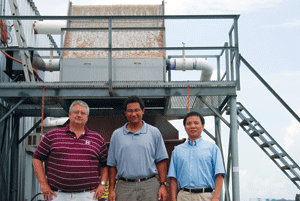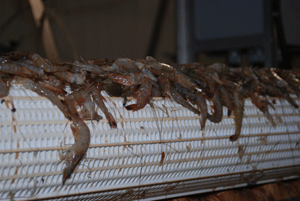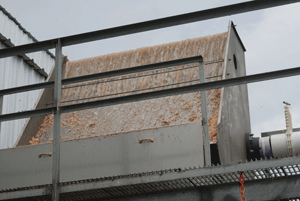MSU scientists study seafood as a feedstock




July 14, 2008
BY Bryan Sims
Scientists at Mississippi State University are embarking on a novel research project to convert shrimp and seafood processing parts that are not used to fill our stomachs into what someday could fuel our diesel engines.
The project is funded by the Mississippi-Alabama Sea Grant Consortium (MASGC). The National Sea Grant College Program, administered by the National Oceanic and Atmospheric Administration (NOAA), is a federal/state partnership that matches NOAA Sea Grant experts and resources with state academic institutions. The MASGC, which was created in 1972, is one of 30 sea grant programs in the United States. In addition to MSU, consortium members include Auburn University, Dauphin Island Sea Lab, Jackson State University, University of Alabama, University of Alabama at Birmingham, University of Mississippi, University of Southern Mississippi and the University of South Alabama.
The goal of the research project is to find a higher value for the millions of tons of shrimp and other seafood waste that gets processed each year near in the Gulf Coast areas of Mississippi, Alabama and Louisiana, according to Todd French, an assistant microbiologist at MSU who is a lead on the project.
"What we're trying to do is find pieces to the puzzle and find something that has a higher value than their byproduct currently has where a lot of times they have to pay to truck off," French said.
Seafood-based biodiesel production would be a boon for existing shrimp processors looking to eliminate some of their disposal costs, which have been estimated at about $145,000 per producer. As a building block for fuel, the waste also would bring additional income streams from the products it's used to create.
French said that the research is focusing on taking advantage of an n-acetyl glucosamine called chitin that's innately found in seafood, such as shrimp, crab and lobster shells. Researchers intend to take the processed seafood waste, pretreat it with an acid and add it to vats of bacterium called Oleatinous, a mixture French refers to as his "bugs". The microorganisms eat the chitin, convert it into fat (or lipids) and store it, which can subsequently be sequestered as a viable oil feedstock intended for biodiesel production.
According to French, the oil produced by the microorganisms is similar to canola oil and corn oil. He said the process is already underway with synthetic seafood ingredients at MSU. The real seafood waste will arrive sometime in August from Gollott's Seafood in Biloxi, Miss.
In addition to using chitin from shrimp and seafood waste, French said the process would also allow seafood processors to recycle wastewater used in seafood processing back into the process for continued operations, including feeding glycerin back into the system to get more oil input.
"Obviously, if the glycerin market is there you want to get the highest value for that," French said. "But, if it's not you can feed it back to the bugs. We've proven that."
French added that although the project is small-scale at the moment, the long-term impact of the project once data verified economic and logistical feasibility should prove itself out in the coming years, French said.
"We had some preliminary data where we used pure n-acetyl glucosamine, but not with the actual shrimp shells, just to prove the concept," French said. "Obviously, we hope the data holds up that [shrimp processors] would find a pilot system and, believe me, every one of those shrimp processors would love to have us on site to find a higher value used for that material."
The project is funded by the Mississippi-Alabama Sea Grant Consortium (MASGC). The National Sea Grant College Program, administered by the National Oceanic and Atmospheric Administration (NOAA), is a federal/state partnership that matches NOAA Sea Grant experts and resources with state academic institutions. The MASGC, which was created in 1972, is one of 30 sea grant programs in the United States. In addition to MSU, consortium members include Auburn University, Dauphin Island Sea Lab, Jackson State University, University of Alabama, University of Alabama at Birmingham, University of Mississippi, University of Southern Mississippi and the University of South Alabama.
The goal of the research project is to find a higher value for the millions of tons of shrimp and other seafood waste that gets processed each year near in the Gulf Coast areas of Mississippi, Alabama and Louisiana, according to Todd French, an assistant microbiologist at MSU who is a lead on the project.
"What we're trying to do is find pieces to the puzzle and find something that has a higher value than their byproduct currently has where a lot of times they have to pay to truck off," French said.
Seafood-based biodiesel production would be a boon for existing shrimp processors looking to eliminate some of their disposal costs, which have been estimated at about $145,000 per producer. As a building block for fuel, the waste also would bring additional income streams from the products it's used to create.
French said that the research is focusing on taking advantage of an n-acetyl glucosamine called chitin that's innately found in seafood, such as shrimp, crab and lobster shells. Researchers intend to take the processed seafood waste, pretreat it with an acid and add it to vats of bacterium called Oleatinous, a mixture French refers to as his "bugs". The microorganisms eat the chitin, convert it into fat (or lipids) and store it, which can subsequently be sequestered as a viable oil feedstock intended for biodiesel production.
According to French, the oil produced by the microorganisms is similar to canola oil and corn oil. He said the process is already underway with synthetic seafood ingredients at MSU. The real seafood waste will arrive sometime in August from Gollott's Seafood in Biloxi, Miss.
In addition to using chitin from shrimp and seafood waste, French said the process would also allow seafood processors to recycle wastewater used in seafood processing back into the process for continued operations, including feeding glycerin back into the system to get more oil input.
"Obviously, if the glycerin market is there you want to get the highest value for that," French said. "But, if it's not you can feed it back to the bugs. We've proven that."
French added that although the project is small-scale at the moment, the long-term impact of the project once data verified economic and logistical feasibility should prove itself out in the coming years, French said.
"We had some preliminary data where we used pure n-acetyl glucosamine, but not with the actual shrimp shells, just to prove the concept," French said. "Obviously, we hope the data holds up that [shrimp processors] would find a pilot system and, believe me, every one of those shrimp processors would love to have us on site to find a higher value used for that material."
Advertisement
Advertisement
Advertisement
Advertisement
Upcoming Events





